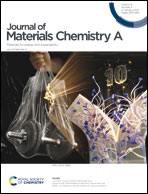Cutting-edge nitrogen, boron, and fluorine triply doped chain-like porous carbon nanofibers: a versatile solution for high-performance zinc–air batteries and self-powered water splitting†
Abstract
Heteroatom-doped carbon catalysts are a class of materials that have been widely studied for their potential to improve the performance and kinetics of electrochemical reactions such as the oxygen reduction/evolution reaction (ORR/OER). However, achieving highly efficient electrochemical activity of tri-heteroatom (N, B, and F) dopants in porous carbon nanofibers (PCNFs) remains challenging. Herein, the strategy involves doping heteroatom species into PCNFs using a simple electrospinning method. The electrospinning process includes crosslinkers such as boric acid, poly(tetrafluoroethylene) (PTFE), and poly(vinyl alcohol) (PVA), which are crosslinked to form a water-soluble network. PVA was utilized as the carbonized polymer, whereas PTFE was used as a sacrificial polymer that was removed during the processing steps to form a porous structure. As a result, the as-spun fibers are formed into N, B, and F triply-doped PCNFs with a large surface area. Taking advantage of the catalyst's unique features, such as its large surface area and the synergistic effect of N, B, and F co-doping, the N, B, and F triply doped PCNF catalyst showed outstanding ORR and OER activity, as well as durability under both alkaline and acidic conditions, with no significant contribution from the metal sites. Additionally, a zinc–air rechargeable battery with N, B, and F doped PCNFs as the air cathode has a long service life and a maximum power density of 151.9 mW cm−2. The developed tri-doped PCNF bifunctional metal-free catalyst, consisting of N, B, and F, is capable of functioning efficiently in ambient air. It exhibits a remarkable gas production rate, with hydrogen (H2) and oxygen (O2) gases being generated at rates of 0.504 and 0.250 μL s−1, respectively. This impressive performance highlights its significant potential for real-world applications.



 Please wait while we load your content...
Please wait while we load your content...